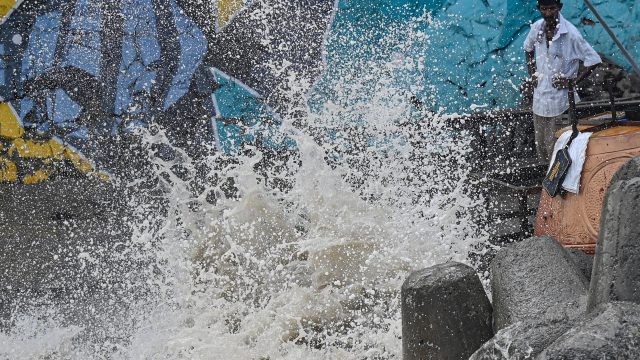More than 100,000 people have been evacuated from the path of a powerful cyclone threatening India and Pakistan, with forecasters warning on Wednesday that it could destroy homes and electricity lines.
Biparjoy, which means “disaster” in Bengali, is moving over the Arabian Sea and is predicted to make landfall as a “very severe cyclonic storm” on Thursday evening, according to government weather forecasters.
A 325-kilometer (200-mile) stretch of coast between Mandvi in India’s Gujarat state and Karachi in Pakistan was expected to be battered by strong winds, storm surges, and lashing rains.
The storm is expected to reach close to the Indian port of Jakhau late Thursday, causing “total destruction” of traditional mud and straw thatched dwellings.
Forecasters warned winds at sea were already blowing up to 180 kilometres per hour (112 miles per hour).
Wind speeds are expected to reach 125-135 kilometers per hour as it makes landfall, with gusts up to 150 kilometers per hour.
“Over 47,000 people have been evacuated from coastal and low-lying areas to seek shelter,” said C.C. Patel, a rescue administrator in Gujarat.
More were anticipated to be transferred inland during the day on Wednesday.
Meteorologists in India warned of the possibility of “widespread damage,” including crop destruction, “bending or uprooting of power and communication poles,” and disruption of railways and roadways.
The streets of Mandvi were mainly deserted on Wednesday, with only a few hungry stray dogs roaming abandoned beach shacks adjacent to big, rolling waves under strong gusts and dark skies.
The Gujarat state government shared photographs of residents clutching little bags of goods and boarding buses inland away from places expected to be struck hardest.
– ‘High to outstanding’
Sherry Rehman, Pakistan’s climate change minister, said Wednesday that 62,000 people had been evacuated off the country’s southeastern shore, and 75 relief camps had been set up at schools and universities.
She added fisherman had been cautioned to remain off the sea, and small planes had been grounded, while urban flooding was possible in Karachi, which has a population of over 20 million people.
“Rather than wait and see,” she told reporters in Islamabad, “we are following a policy of caution.” “Our first priority is saving lives.”
The Pakistan Meteorological Department predicts gusts of up to 140 km/h in Sindh’s southeastern province, along with a storm surge of up to 3.5 metres (11.5 feet).
Fishing has also been suspended throughout the Gujarat coast, with conditions anticipated to worsen from “rough to very rough” to “high to phenomenal” on Wednesday.
“There could be flooding in some low-lying areas, and we are prepared to handle that,” Mohsen Shahedi, a senior official with India’s National Disaster Response Force, told reporters.
Five people have already been murdered in India, including two toddlers who were crushed when a wall collapsed and a woman who was on a motorcycle when she was hit by a falling tree.
Cyclones, which are the equivalent of hurricanes in the North Atlantic or typhoons in the Northwest Pacific, are a common and fatal threat along the northern Indian Ocean coast, where tens of millions of people dwell.
Storms are becoming more powerful as the planet warms due to climate change, according to scientists.



